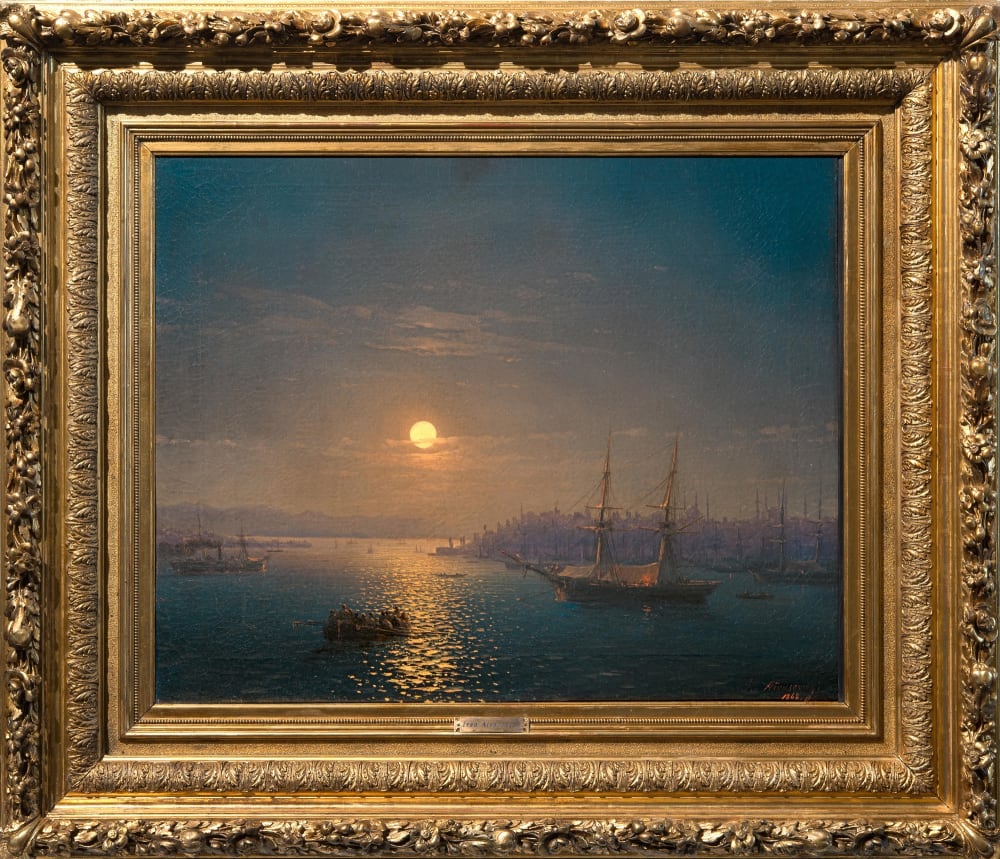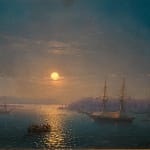


Iwan Konstantinowitsch Aivazovsky
Istanbul: The Golden Horn by Moonlight, 1868
Oil on canvas
63,3 x 76,4 cm
Signed and dated lower right: Aivazovsky 1868.
Provenance
Private Collection, Germany
Iwan Konstantinowitsch AIVAZOVSKY
(Feodosia, 1817 – 1900)
"By the time he was twenty-eight, Aivazovsky had been all over Europe, to England, Holland and Spain; he had achieved international fame, and sold paintings to the Emperor of Russia and the Pope in Rome; he had met William Turner, and had been elected to several European Academies; but he had never visited Istanbul, the great capital of the Ottoman Empire which loomed just two hundred miles across the sea from his birthplace. Aivazovsky grew up in Theodosia, an ancient Crimean port once affectionately named Küçük Stambul,‘Little Istanbul’ by the Ottomans who ruled it until the 18th century. He was born on the extreme edge of the extensive Russian Empire, with its proud capital in cold, distant St. Petersburg, the ‘Venice of the North’. It was to Petersburg that he won a scholarship and where he established his reputation as a painter. But his constitution was unsuited to the damp northern climate, and he spent much of his student life in the Academy sick bay. In later years, although a Professor of the Academy, he preferred to reside in his home town on the banks of the Black Sea.
The occasion for this first voyage to Istanbul was an expedition by sea to accompany Grand Duke Konstantin Nikolaievich, a younger son of Emperor Nicholas I who had taken up a career in the Imperial Navy. Aivazovsky, who had already accompanied the Grand Duke on a previous tour of the Baltic, was appointed official painter to the expedition, which was led by Admiral Litke, a geographer and member of the Russian Imperial Academy of Sciences. The expedition visited the Aegean islands, the shores of Anatolia and the Levant before reaching Istanbul. Aivazovsky saw in the city the most perfect setting for his talent. Sited on a triangular peninsula at the junction of many waters, sweet and salt, the city fulfils all the standards of beauty that the most demanding artist can require. The scene before him presented him with a cityscape, landscape and seascape. Streams ran through groves of bamboo at the mouths of grassy valleys, and scented flowers filled the air. He saw domed mosques and churches, palaces with many courtyards, gardens, bazaars and squares. Istanbul, with its climate, familiar Black Sea food, and magical architecture that reflected its long history was a revelation to the young artist. He was to paint it from every angle; from the heights of Galata, from across the Golden Horn, at sunset, sunrise and under moonlight.
This was the first of eight trips Aivazovsky was to make to the Ottoman capital. It also coincided with a change in his working methods; until this time, influenced by his teachers at the Academy, he had tried to paint “en plein air”, directly from nature as was the fashion among the preceding generation of Romantic painters. But this was a method that never suited him, and during the expedition to Asia Minor he began to make sketches, which he would later work up into paintings in his studio. These sketches would serve him all his life. He did not feel it necessary, nor even possible, to paint a wave or a moonbeam directly onto a canvas. The movement of live waves cannot be caught by the paintbrush: to paint from nature lightning, a gust of wind, the splash of a wave is unthinkable. In order to do this the artist must remember them and furnish his painting with these chance effects, just as he does with the effects of light and shade...I am incapable of painting quietly, sweating over a picture for months on end. I compose the subject of a painting in my memory, just as a poet does verse; having made a sketch on a piece of paper, I set to work, and do not leave the canvas, until I have expressed myself upon it with my brush... Paintings lit by the moon were an important element of Aivazovsky’s work; in 1842, at an exhibition in Paris, it is reported that visitors tried to get behind the paintings to check for lights or lanterns, so intensely did the pictures glow.
In our picture, which is painted from the vantage point of the hills above the recently constructed Dolmabahçe Palace, the European side is divided from the Asian side by a thick impasto of moonbeams reflected in the choppy sea, while the same moon lights up the silhouettes of Hagia Sophia and the Blue Mosque from behind."
Ivan Samarin
Certificate by Ivan Samarine, London, February 2023.
Join the mailing list
Subscribe to our newsletter to receive all the news about exhibitions, fairs and new acquisitions!

